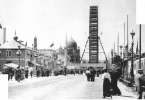The most beautiful point to emphasise in relation to Ottoman women of the 19th century and the following years, is their character that surfaced in society as well as their noble roles they took upon within their families in raising and embedding the notion of the motherland in the thousands of young people who walked to their deaths in the beginning of the 20th century. From the times of the Ottoman times until the Republic, women have undertaken many great roles varying from government, art, faith and sports within the Turkish society. Ever since the establishment of the Ottoman Empire, women have taken their status in the historical events due to their crucial moves both within the palace and the administration and have become the hidden heroes of the world of culture with their works in art and literature. Hurrem Sultan was perhaps one of the most forthcoming amongst the Ottoman palace women, who were raised to be the future mother of Sultans with the private lessons knowledge in the Harems. According to resources and contrary to popular culture, Hurrem Sultan was actually a well educated sultan who spoke a few language, was interested in literature and was also influential in the administration within the palace. Despite the political depressions and external pressures during the Ottoman Empire during its journey towards the Reform Era, the influence of women within society never decreased. Women, during that time, had played a great role as being the wise figures within their families,
as well as their maturity in faith and conveyance of culture and experience. Without a doubt, Halide Edip is one of the most prominent figures who led the Turkish women during the Reform Era and the period that followed. Adıvar, who became one of the most influential women
of her era with the speeches she delivered during the National Struggle years, continued to play her crucial part with her books and political struggles during the transformation to the Republican system. Within the scope of the modernisation of women that was initiated with the Reforms, the Turkish woman figure surfaced both in private lives as well as during social processes. Many young girls started to
receive education at primary and high school levels due to the steps taken in education and in the busineses life. With the influence of the relations with Europe, European women taught Turkish children to play the piano and other similar instruments and also taught
languages like French. In discussing Ottoman women, we ought to also take a look at the minority women groups during the Ottomans. In the notes of the voyagers from that era, it is stated that Armenian women dressed like Muslim women and also covered their faces with a niqab.
Pursuant to all of these developments and particularly in light of the Second Constitutionalist Period, many current issues in regards to women were discussed. The appearance of the first women’s magazines were also published during this period. The fact that women were also amongst the authors of these publications does not prove that there was only an increase in the number of female readers but was evidence of the fact that women who were writing and producing were also developing simultaneously. The rising of the status of women, especially as
a result of the education received and the active professional lives, would become hindered by the World War I that had been long expected. If we are to speak about Turkish women, we ought to speak of the patriotic women during the war years. Once the men was sent to the frontlines of the war, in which the Ottomans were forced to enter, the women had to shoulder all of the responsibilities of the home and there had been times when they also went to the frontlines to fight. Nene Hatun is one of the most important figures who is noted down in history. Nene Hatun, who is still remembered today and whose fame also is known overseas, is considered a hero for all of her efforts in the defence of the country. It can be confidently stated that this country has been erected on the selfsacrifices of Turkish women. AND THE REPUBLIC… With the establishment of the Republic, Turkey became a country with definite borders. With the implementation of the principles and reforms, the modern Turkish woman was able to take her role in society as a teacher, lawyer, doctor and in many other positions. Our first Turkish female pilot Sabiha Gökçen and our artist Afife Jale are amongst the most prominent Turkish female figures of the republican era. Whether it be during the establishment of the Ottoman or the Republic, strong female profiles such as Hayme Ana and Halide Edip Adivar were always in the forefronts. The acceptance of Islam had contributed to this fact and women have ever since continued to undertake their valuable contributions to the Turkish and Muslim lands.
The Turkish Woman: From the Ottoman to the Republic
Whether it be with their stand in the face of historical events or their works in art and literature, they are the hidden heroes of the cultural world.









Leave a Comment